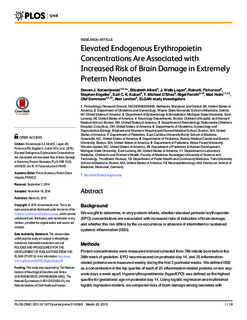| dc.description.abstract | Background:
We sought to determine, in very preterm infants, whether elevated perinatal erythropoietin
(EPO) concentrations are associated with increased risks of indicators of brain damage,
and whether this risk differs by the co-occurrence or absence of intermittent or sustained
systemic inflammation (ISSI).
Methods:
Protein concentrations were measured in blood collected from 786 infants born before the
28th week of gestation. EPO was measured on postnatal day 14, and 25 inflammationrelated
proteins were measured weekly during the first 2 postnatal weeks. We defined ISSI
as a concentration in the top quartile of each of 25 inflammation-related proteins on two separate
days a week apart. Hypererythropoietinemia (hyperEPO) was defined as the highest
quartile for gestational age on postnatal day 14. Using logistic regression and multinomial
logistic regression models, we compared risks of brain damage among neonates with hyperEPO only, ISSI only, and hyperEPO+ISSI, to those who had neither hyperEPO nor
ISSI, adjusting for gestational age.
Results:
Newborns with hyperEPO, regardless of ISSI, were more than twice as likely as those without
to have very low (< 55) Mental (OR 2.3; 95% CI 1.5-3.5) and/or Psychomotor (OR 2.4;
95% CI 1.6-3.7) Development Indices (MDI, PDI), and microcephaly at age two years (OR
2.4; 95%CI 1.5-3.8). Newborns with both hyperEPO and ISSI had significantly increased
risks of ventriculomegaly, hemiparetic cerebral palsy, microcephaly, and MDI and PDI < 55
(ORs ranged from 2.2-6.3), but not hypoechoic lesions or other forms of cerebral palsy, relative
to newborns with neither hyperEPO nor ISSI.
Conclusion:
hyperEPO, regardless of ISSI, is associated with elevated risks of very low MDI and PDI,
and microcephaly, but not with any form of cerebral palsy. Children with both hyperEPO
and ISSI are at higher risk than others of very low MDI and PDI, ventriculomegaly, hemiparetic
cerebral palsy, and microcephaly. | nb_NO |
